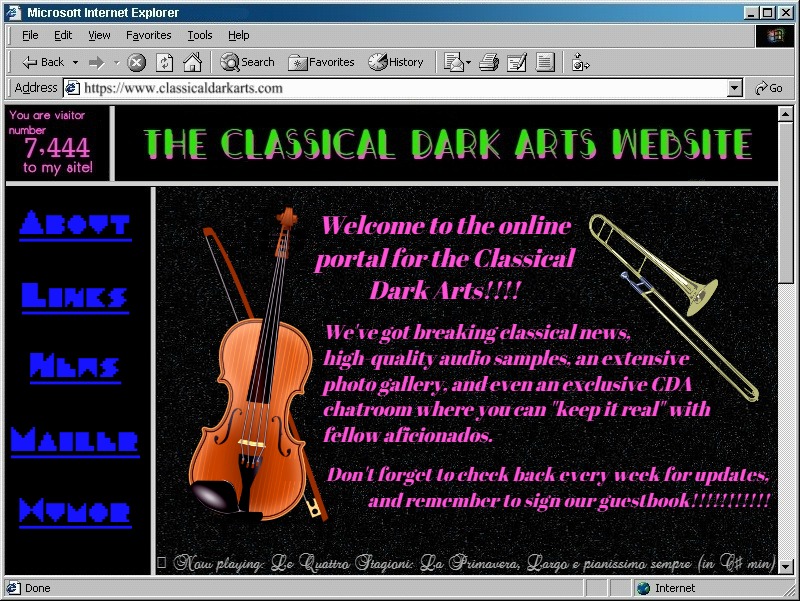
The early nineties were a magical time to be online. You could never predict what you’d come across: dancing text, indecipherable fonts, busted links, page elements all the colors of the rainbow, and grainy photos loading pixel by painstaking pixel. That is, if you were able to get there at all. After the agonizing desktop start-up ritual — a procession of clicks and whirs, the labored whining of vent fans and spinning disk drives, mysterious bloops and beeps — you’d mash the internet icon with too many clicks, await the inimitable sound of a dial-up modem as it called down the line, and then, no small miracle, you’d be online.
Tim Berners-Lee invented the World Wide Web in 1989 as a way to formalize gathering places, websites, on the internet. But what began as a charming haven for coders and explorers morphed into a commercial feeding frenzy for brands and hucksters. The web was particularly well-suited for classical music fans, but like other pursuits it worked even better for marketing and sales. While diehard collectors traded bits of classical ephemera on message boards, every big classical music outfit jumped online to flog tickets, subscriptions, and CDs.
Below you’ll see the first forays onto the web for the so-called “Big Five” US orchestras: the first websites for the Boston Symphony, the Chicago Symphony, the Cleveland Orchestra, the New York Philharmonic, and the Philadelphia Orchestra. These are maybe not the very first images of their sites — the majority come from 1996 onward, and certainly none exist from the web’s inception in 1989. However, they are the oldest remaining snapshots available on the Internet Archive Wayback Machine. They are artifacts that remind us, at least from the commercial side, how this all began.
Let’s roll the tape.
Boston Symphony Orchestra
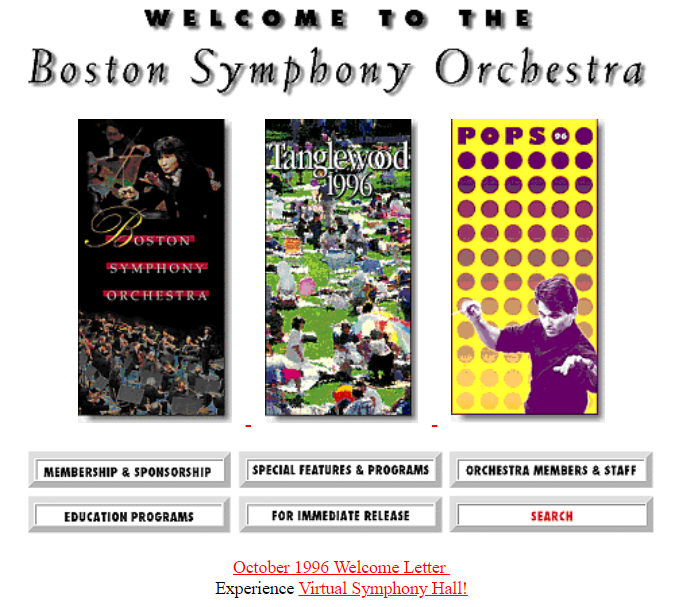
Website: bso.org
First crawled: 19 October 1996
Designed by: Pegasus Internet, Inc.
Music director at the time: Seiji Ozawa
Level of preservation: Quite high, very little missing, worth a visit
Design grade: B/B+
Relic of early-web mentality: Scrolling down the homepage leads you to the Virtual Symphony Hall!, and clicking on that link will … OH GOD LOOK OUT IT’S AN AUTO-DOWNLOADED VIDEO. In case you don’t want to hassle with a pointless video in an outmoded format here’s how it looks — a 360-degree swing around the hall on somebody’s shitty point-and-shoot camera. Sideways.
General remarks: This was a well-planned site with a slew of information about the orchestra, its conductor, the hall, and etc. For collectors they’ve also got an impressive catalog of BSO albums and broadcasts. Many of its pages have been preserved here in the archive. However, I am sad to report that the “Supper Series” link with a picture of a big, juicy steak leads nowhere. No meat for you.
Chicago Symphony Orchestra
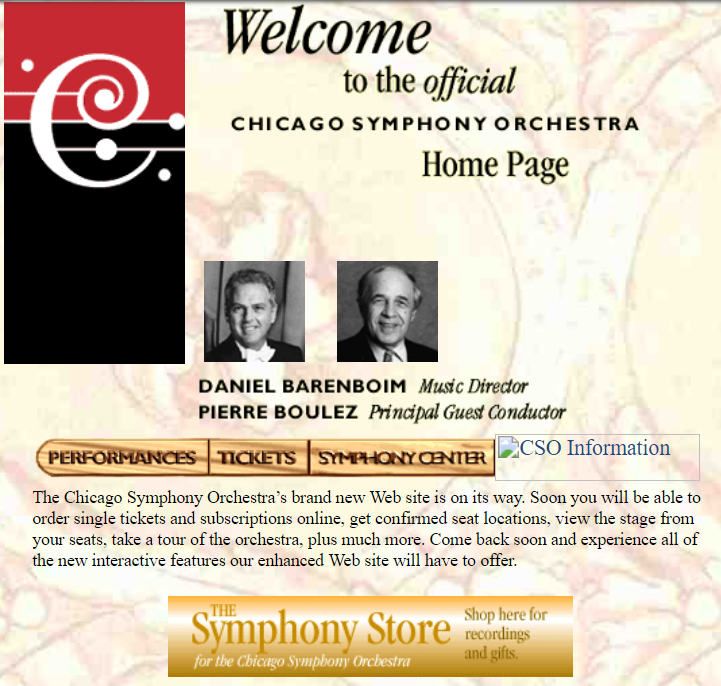
Website: cso.org
First crawled: 26 December 1996 (Chicago Symphony took control of cso.org by 10 June 2000; above image is from 15 August 2000)
Designed by: Pegasus Internet, Inc.
Music director at the time: Daniel Barenboim
Level of preservation: Pretty tough, lots of dead links/images
Design grade: C+, and that’s being generous with that godawful background and wood-grain buttons
Relic of early-web mentality: A note in the online Symphony store reads: “With your safety in mind, all online orders are fully encrypted, providing optimum security to Internet shoppers. If you would still rather not give credit information online, our order form can also be faxed or mailed.” So cute, so quaint. Fax me.
General remarks: CyberStrategies, Inc. from Upland, California was the first company to own cso.org, and I’m happy to report they are still doing business in web design. (They switched domains and dropped the CamelCaps from their name, alas.) There were some great URL redirects in the web’s early days, where the site’s content didn’t remotely resemble what you expected when you typed the address into Netscape. (See: WhiteHouse.com.) Usually it was a ploy to make a buck, but I don’t think CyberStrategies was squatting on cso.org. In 2000 the Chicago Symphony finally laid claim to cso.org. 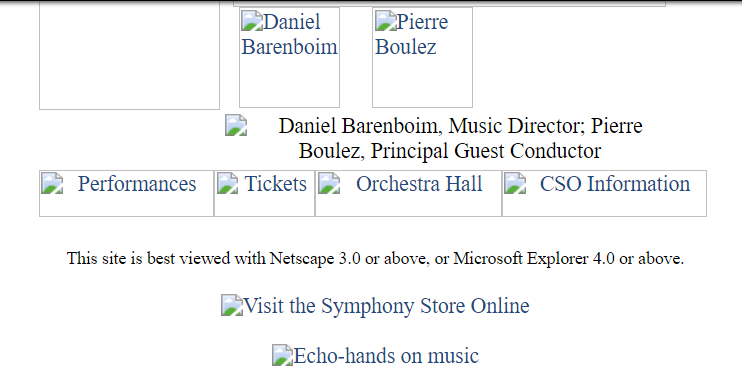
The embedded images from the site’s first days are inexplicably missing. Maybe it’s because we’re not viewing it in the right browser. As they note: “This site is best viewed with Netscape 3.0 or above, or Microsoft Explorer 4.0 or above.”
The Cleveland Orchestra
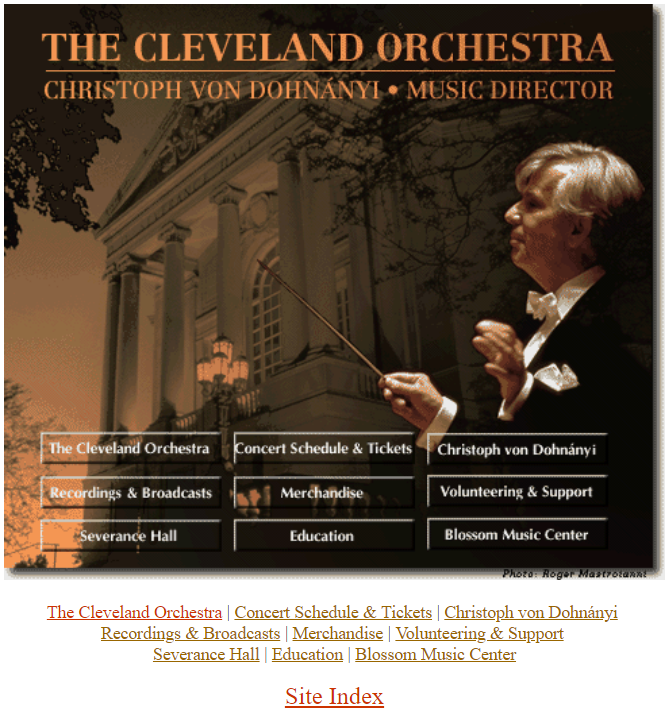
Website: clevelandorch.com
First crawled: 21 December 1996
Website designed by: Unavailable
Music director at the time: Christoph von Dohnányi
Level of preservation: Perfect. If this were a vintage baseball card it would get a “Gem-mint” rating
Design grade: A-
Relic of early-web mentality: I’m grasping at straws here, because so much of the site was fully-formed at inception. This is nice though: “To order a VHS copy of Cleveland Plays the Proms ($19.95) Call (216) 231-7300.” The phone number still works! They probably still sell the VHS. (Nobody answered when I called.) The site also had one of those mystifying navigation buttons (Back, Next, Top, Bottom, etc.) that sites still insist on putting in, as if anybody reads them like books or newspapers.
Remarks: Clevelandorch.com was slow to start, and then suddenly the best online orchestral concern, at least of the Big Five. By slow I mean that the first couple times it was crawled this was all you’d see:
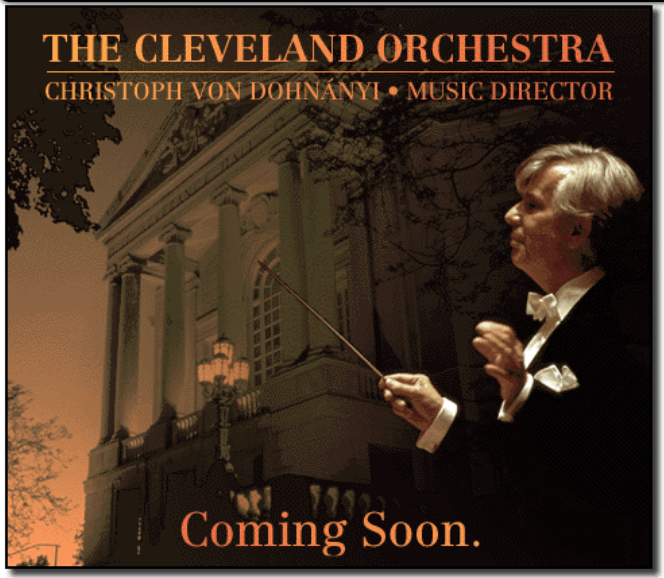
But by 14 April 1997 they were open for business. This was a meticulously constructed website that is now flawlessly preserved. You could take them down a peg or two for the drab pictures and color schemes. But really, take all this content and just dump it right off in 2019.
New York Philharmonic
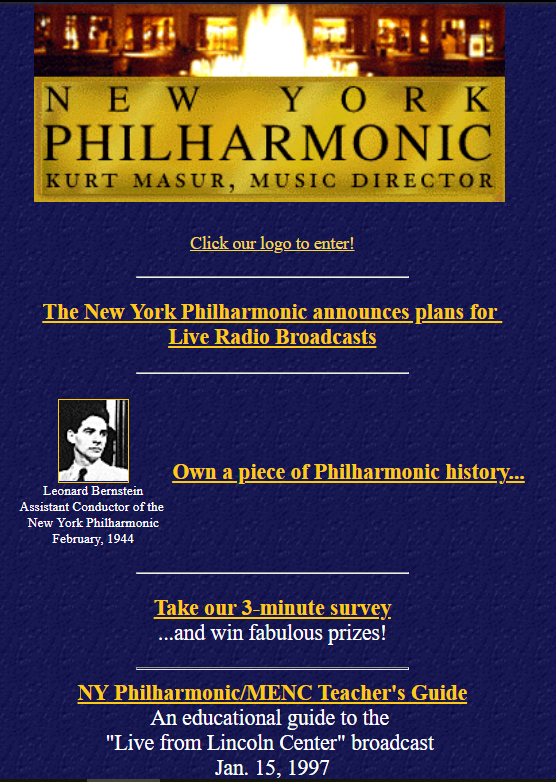
Website: newyorkphilharmonic.org
Date first crawled: 21 December 1996
Music director at the time: Kurt Masur
Website designed by: Pegasus Internet, Inc.
Level of preservation: Decent, but too many dead links
Design grade: C-
Relic of early-web mentality: The NY Phil included a massive amount of “teaching materials” to accompany the orchestra’s Live from Lincoln Center broadcast on PBS in 1997. Among the materials was this gem essentially explaining what hyperlinks are:
“A technical note… Clicking on any of the (normally) blue, underlined words in the text will get some sort of response–presentation of more explanation of a given topic, suggestion of a sample answer to a question posed in a lesson plan, or the playing of some music.”

Remarks: Question: what is a “Magellan 4-star Site,” and how did the NY Phil’s site get certified as one? Is it a rigorous annual certification that must be passed, like a restaurant health inspection? Was this a prestigious award? Oh hell, enough questions. I’ll just Bing it. This is from a 1996 email the McKinley Group — Magellan’s parent company — sent out after awarding another site, Messier Pages, the coveted four stars:
We are delighted to designate your resource as a ‘4-Star’ site. This is the highest rating an Internet site can achieve in Magellan, McKinley’s comprehensive Internet directory of nearly 2 million sites and 40,000 reviews. As a Magellan 4-Star site, you are being awarded a special logo to recognize the hard work that has gone into establishing and maintaining your site.
So Magellan was like a ratings clearinghouse crossed with the Yellow Pages. Now you know. Anyway, hats off to Pegasus Internet, Inc. on the recognition.
Philadelphia Orchestra
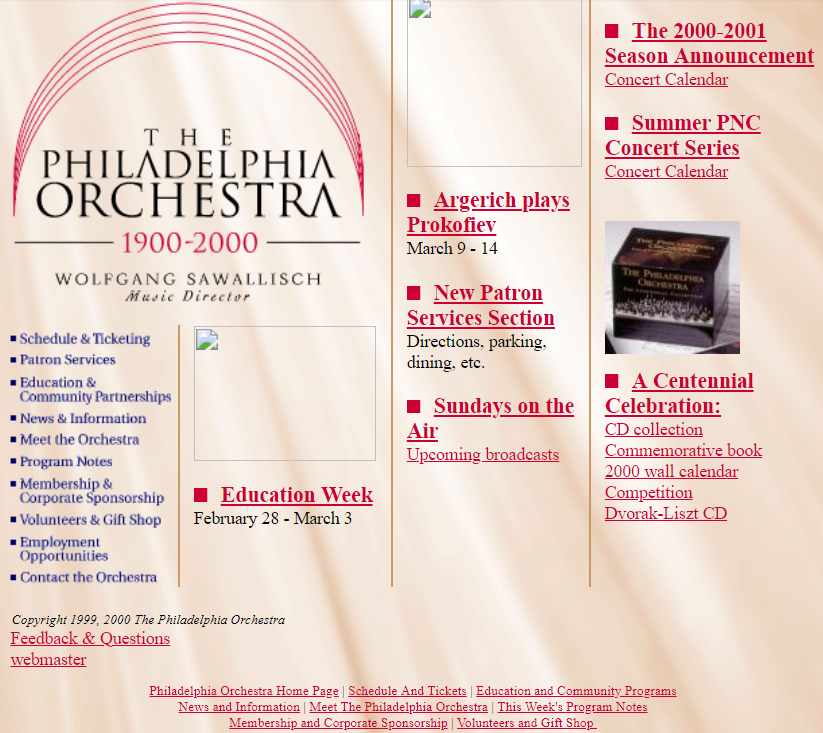
Website: philorch.org
Date first crawled: 11 November 1998 (above image is from 1 March 2000)
Website designed by: Myxa Corporation
Music director at the time: Wolfgang Sawallisch
Level of preservation: Shot through with holes, pretty tough to appreciate the very first iteration; subsequent crawled pages were much better
Design grade: C
Relic of early-web mentality: One section of philorch.org promises a forthcoming set of pictures from the Philadelphia Orchestra’s “spook”-tacular Halloween concerts, and then goes on to describe said pictures without so much as a single visual component. What a compelling tease! Prepare yourself for “Monarch Butterfly timpani player” and the “Roman Centurion Trombone Section.” Coming … sometime. Just not yet. Also, the site’s tagline “Welcome to our Symphonic Cyberstage. Enjoy browsing!” is so innocent and pure it pains me.
Remarks: The Philadelphia Orchestra still called the Academy of Music its home at this time — they hadn’t yet moved into the gigantic Kimmel Center. From the looks of it Philly was late in establishing its web presence, but they got there in ’98. The first screen caps of the site show this page with exactly zero pictures archived, and one bossy directive (“Take your seat!”) sitting atop a busted link:

You gotta do some serious clicking to find the lone picture of (who I imagine to be) Maestro Sawallisch, conducting:

Yikes. Reassuringly, the orchestra sought a “Webmaster” to “Design, build, manage and maintain the web-site. […] Provide technical support for all problems related to the web site.” That Webmaster, we now know from later screen captures, turned out to be the Myxa Corporation, and they arrived just in time.
2 replies on “How the ‘Big Five’ American Orchestras Crawled onto the World Wide Web”
[…] It was back in the late 1990s and the idea of being online was new. Hence explanations of how the web and websites worked… – Classical Dark Arts […]
[…] obtained that concept from feedback on a good-natured submit I did, citing Will Roseliep’s writing concerning the first web sites the Huge 5 ever created. Interval items, all of them, As in fact […]